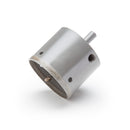Description
Use Blazer Dry Diamond Tile Hole Saws to drill holes in hard porcelain tile 3/4" thick, ceramic, glass mosaic tiles, and even cast iron sinks. It can also be used on stone, however, we recommend using a stone core bit. The Blazer tile hole saw bit is perfect for making holes in sinks for water filters and installing bathroom fixtures.
Sizes 1" and up come with a removable carbide pilot bit in the center. This bit can be adjusted by loosening the set screw to be slightly above the cutting rim. Once the hole is established remove the pilot bit to allow the diamond cutting rim to cut more efficiently. You can also use a piece of wood as a template and remove the pilot bit before starting the hole.
- Produce clean and accurate holes in minutes with no chipping!
- Sizes 1/2"-7/8" do not have a carbide pilot (center) bit. Sizes 1" - 4" come with a removable carbide pilot bit. We suggest using a piece of wood as a template to keep the bit stable when starting a hole without the pilot bit.
- Use with low-speed drills or drill presses (500-2,500 RPM).
Limited Lifetime Warranty
All diamond tool products including blades, coring bits, hole saws and grinding wheels include a limited lifetime warranty against warping, cracking and material defects. If any diamond tool (being used for its intended purpose with at least 50% of the diamond life remaining) fails to cut or work properly, or if the bond between the diamond segment and the steel core becomes separated at any time, the tool may be replaced free of charge.


